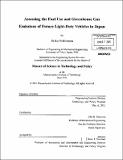| dc.contributor.advisor | Jolin B. Heywood. | en_US |
| dc.contributor.author | Nishimura, Eriko | en_US |
| dc.contributor.other | Massachusetts Institute of Technology. Technology and Policy Program. | en_US |
| dc.coverage.spatial | a-ja--- | en_US |
| dc.date.accessioned | 2011-08-30T15:43:38Z | |
| dc.date.available | 2011-08-30T15:43:38Z | |
| dc.date.copyright | 2011 | en_US |
| dc.date.issued | 2011 | en_US |
| dc.identifier.uri | http://hdl.handle.net/1721.1/65506 | |
| dc.description | Thesis (S.M. in Technology and Policy)--Massachusetts Institute of Technology, Engineering Systems Division, Technology and Policy Program, 2011. | en_US |
| dc.description | Cataloged from PDF version of thesis. | en_US |
| dc.description | Includes bibliographical references (p. 90-95). | en_US |
| dc.description.abstract | Reducing greenhouse gas (GHG) emissions is of great concern in Japan, as well as elsewhere, such as in the U.S. and EU. More than 20% of GHG emissions in Japan come from the transportation sector, and a more than 70% reduction in GHG emissions by 2050 has been projected as a feasible goal. It is clear that substantial reduction in GHG emissions from the transportation sector will be required in Japan over the next several decades. This research developed a fleet model for Japan to evaluate GHG emission trends through 2030 and through 2050. The fleet model shows that GHG emissions from light-duty vehicles are likely to decrease significantly due to anticipated decrease of vehicle kilometers traveled (VKT) from all the light-duty vehicles in Japan over the next several decades. This is because of several factors, such as the decrease of vehicle sales due to the recession and higher gasoline prices. In the analysis through 2030, the fleet model was run under four "sales mix scenarios," including a scenario which is based on the forecast by the Japanese Government. Even in the scenario without any sales mix change in the future, a 36% GHG emission reduction from the level of 2008 is achieved by 2030. In the Government Scenario (the most optimistic scenario), a 49% GHG emission reduction from the level of 2008 is achieved by 2030. In the longer-term analysis through 2050, the fleet model was run under two "sales mix scenarios" and two "vehicle fuel consumption forecasts." In the most conservative case, a 54% GHG emission reduction from the level of 2008 is achieved by 2050. In the most optimistic case, a 67% GHG emission reduction from the level of 2008 is achieved by 2050. Even though substantial GHG emission reductions by 2050 are projected, coordinated policy measures would make the most optimistic sales mix scenario more feasible, and help realize further GHG emission reductions. | en_US |
| dc.description.statementofresponsibility | by Eriko Nishimura. | en_US |
| dc.format.extent | 95 p. | en_US |
| dc.language.iso | eng | en_US |
| dc.publisher | Massachusetts Institute of Technology | en_US |
| dc.rights | M.I.T. theses are protected by
copyright. They may be viewed from this source for any purpose, but
reproduction or distribution in any format is prohibited without written
permission. See provided URL for inquiries about permission. | en_US |
| dc.rights.uri | http://dspace.mit.edu/handle/1721.1/7582 | en_US |
| dc.subject | Engineering Systems Division. | en_US |
| dc.subject | Technology and Policy Program. | en_US |
| dc.title | Assessing the fuel Use and greenhouse gas emissions of future light-duty vehicles in Japan | en_US |
| dc.type | Thesis | en_US |
| dc.description.degree | S.M.in Technology and Policy | en_US |
| dc.contributor.department | Massachusetts Institute of Technology. Engineering Systems Division | |
| dc.identifier.oclc | 746765350 | en_US |
